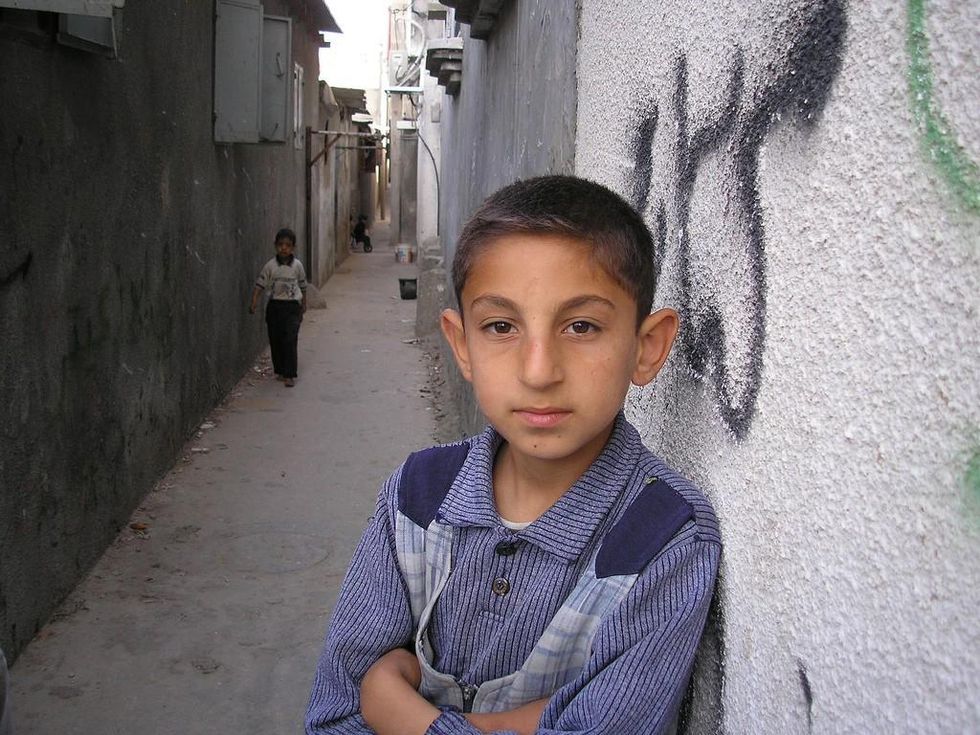
Israeli soldiers keep guard at military checkpoint near Qalandia in the occupied West Bank. (Photo:REUTERS)
To donate by check, phone, or other method, see our More Ways to Give page.

Israeli soldiers keep guard at military checkpoint near Qalandia in the occupied West Bank. (Photo:REUTERS)
Read this headline from the New York Times (11/16/14):
Think for a second about what kind of image that calls up. How much does that image change when you read the story's second sentence?
A spokeswoman for the hospital said the Palestinian was a 10-year-old boy.
Now, very few people read the full text of every story in any newspaper, so as an editor you have to ask yourself what a headline conveys on its own. I expect that most people who only read that headline assumed that the Palestinian referenced was an adult-and likely had a different reaction to the story as a result.
They were probably also less likely to read the story-the opposite of the effect that you usually want to have with a headline-which makes you wonder why the Times would leave this key fact out. Space, maybe? But "Gazan Boy Shot by Israeli Troops at Border" would have fit just as easily.

Or "Child Shot by Israeli Troops at Gaza Border," for that matter, since the shooting victim's likely nationality would be clear from context; there aren't too many Israeli children near the border with Gaza. In any case, the victim's age is arguably a more important fact than his ethnicity.
So-did the editors leave out of the headline the fact that it was a child who had been shot because they didn't want readers to get too upset about Israel doing the shooting?
Surely they would say no-but recall that New York Times story (7/16/14; FAIR Blog, 7/17/14), accurately headlined "Four Young Boys Killed Playing on Gaza Beach," that was rewritten for the print edition as "Boys Drawn to Gaza Beach, and Into Center of Mideast Strife." Here the boys remained boys, but their deaths disappeared.
When Times public editor Margaret Sullivan (7/22/14) asked why the headline had been changed, executive editor Dean Baquet claimed that print headlines tend to be "a little poetic." Keats it ain't.
To take a quantitative look at this phenomenon, let's move from the New York Times to an outlet that fancies itself to be the New York Times of the airwaves-NPR. FAIR's Seth Ackerman (Extra!, 11/01) did a study of which deaths it reported in the Israeli/Palestinian conflict over a six-month period. He found that NPR reported 81 percent of the Israeli deaths during that time, and 89 percent of the deaths of Israeli children-but only 34 percent of the Palestinian deaths, and 26 percent of the deaths of Palestinian children.
So while NPR-understandably-thought that being a child made an Israeli victim's death more newsworthy, if Palestinian victims were children that made NPR less likely to report their deaths.
That's an odd sort of news judgment-unless what's being aimed at is not maximizing human interest, but keeping it to a minimum.
Common Dreams is powered by optimists who believe in the power of informed and engaged citizens to ignite and enact change to make the world a better place. We're hundreds of thousands strong, but every single supporter makes the difference. Your contribution supports this bold media model—free, independent, and dedicated to reporting the facts every day. Stand with us in the fight for economic equality, social justice, human rights, and a more sustainable future. As a people-powered nonprofit news outlet, we cover the issues the corporate media never will. Join with us today! |
Read this headline from the New York Times (11/16/14):
Think for a second about what kind of image that calls up. How much does that image change when you read the story's second sentence?
A spokeswoman for the hospital said the Palestinian was a 10-year-old boy.
Now, very few people read the full text of every story in any newspaper, so as an editor you have to ask yourself what a headline conveys on its own. I expect that most people who only read that headline assumed that the Palestinian referenced was an adult-and likely had a different reaction to the story as a result.
They were probably also less likely to read the story-the opposite of the effect that you usually want to have with a headline-which makes you wonder why the Times would leave this key fact out. Space, maybe? But "Gazan Boy Shot by Israeli Troops at Border" would have fit just as easily.

Or "Child Shot by Israeli Troops at Gaza Border," for that matter, since the shooting victim's likely nationality would be clear from context; there aren't too many Israeli children near the border with Gaza. In any case, the victim's age is arguably a more important fact than his ethnicity.
So-did the editors leave out of the headline the fact that it was a child who had been shot because they didn't want readers to get too upset about Israel doing the shooting?
Surely they would say no-but recall that New York Times story (7/16/14; FAIR Blog, 7/17/14), accurately headlined "Four Young Boys Killed Playing on Gaza Beach," that was rewritten for the print edition as "Boys Drawn to Gaza Beach, and Into Center of Mideast Strife." Here the boys remained boys, but their deaths disappeared.
When Times public editor Margaret Sullivan (7/22/14) asked why the headline had been changed, executive editor Dean Baquet claimed that print headlines tend to be "a little poetic." Keats it ain't.
To take a quantitative look at this phenomenon, let's move from the New York Times to an outlet that fancies itself to be the New York Times of the airwaves-NPR. FAIR's Seth Ackerman (Extra!, 11/01) did a study of which deaths it reported in the Israeli/Palestinian conflict over a six-month period. He found that NPR reported 81 percent of the Israeli deaths during that time, and 89 percent of the deaths of Israeli children-but only 34 percent of the Palestinian deaths, and 26 percent of the deaths of Palestinian children.
So while NPR-understandably-thought that being a child made an Israeli victim's death more newsworthy, if Palestinian victims were children that made NPR less likely to report their deaths.
That's an odd sort of news judgment-unless what's being aimed at is not maximizing human interest, but keeping it to a minimum.
Read this headline from the New York Times (11/16/14):
Think for a second about what kind of image that calls up. How much does that image change when you read the story's second sentence?
A spokeswoman for the hospital said the Palestinian was a 10-year-old boy.
Now, very few people read the full text of every story in any newspaper, so as an editor you have to ask yourself what a headline conveys on its own. I expect that most people who only read that headline assumed that the Palestinian referenced was an adult-and likely had a different reaction to the story as a result.
They were probably also less likely to read the story-the opposite of the effect that you usually want to have with a headline-which makes you wonder why the Times would leave this key fact out. Space, maybe? But "Gazan Boy Shot by Israeli Troops at Border" would have fit just as easily.

Or "Child Shot by Israeli Troops at Gaza Border," for that matter, since the shooting victim's likely nationality would be clear from context; there aren't too many Israeli children near the border with Gaza. In any case, the victim's age is arguably a more important fact than his ethnicity.
So-did the editors leave out of the headline the fact that it was a child who had been shot because they didn't want readers to get too upset about Israel doing the shooting?
Surely they would say no-but recall that New York Times story (7/16/14; FAIR Blog, 7/17/14), accurately headlined "Four Young Boys Killed Playing on Gaza Beach," that was rewritten for the print edition as "Boys Drawn to Gaza Beach, and Into Center of Mideast Strife." Here the boys remained boys, but their deaths disappeared.
When Times public editor Margaret Sullivan (7/22/14) asked why the headline had been changed, executive editor Dean Baquet claimed that print headlines tend to be "a little poetic." Keats it ain't.
To take a quantitative look at this phenomenon, let's move from the New York Times to an outlet that fancies itself to be the New York Times of the airwaves-NPR. FAIR's Seth Ackerman (Extra!, 11/01) did a study of which deaths it reported in the Israeli/Palestinian conflict over a six-month period. He found that NPR reported 81 percent of the Israeli deaths during that time, and 89 percent of the deaths of Israeli children-but only 34 percent of the Palestinian deaths, and 26 percent of the deaths of Palestinian children.
So while NPR-understandably-thought that being a child made an Israeli victim's death more newsworthy, if Palestinian victims were children that made NPR less likely to report their deaths.
That's an odd sort of news judgment-unless what's being aimed at is not maximizing human interest, but keeping it to a minimum.